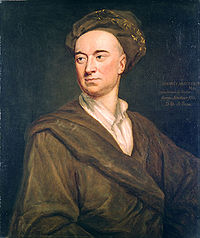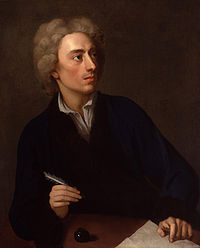
Epistle to Dr Arbuthnot
Encyclopedia
The Epistle
to Dr. Arbuthnot is a satire in poetic form written by Alexander Pope
and addressed to his friend John Arbuthnot
, a physician. It was first published in 1735 and composed in 1734, when Pope learned that Arbuthnot was dying. Pope described it as a memorial of their friendship. It has been called Pope's "most directly autobiographical work," in which he defends his practice in the genre of satire and attacks those who had been his opponents and rivals throughout his career.
Both in composition and in publication, the poem had a checkered history. In its canonical form, it is composed of 419 lines of heroic couplet
s. Epistle to Arbuthnot is notable as the source of the phrase "damn with faint praise
," used so often it has become a cliché
or idiom
. Another of its notable lines is "Who breaks a butterfly upon a wheel?
"
 John Arbuthnot
John Arbuthnot
was a physician known as a man of wit. He was a member of the Martinus Scriblerus Club, along with Pope, Jonathan Swift
and John Gay
. He was formerly the physician of Queen Anne
. On 17 July 1734, Arbuthnot wrote to Pope to tell him that he had a terminal illness. In a response dated 2 August, Pope indicates that he planned to write more satire, and on 25 August told Arbuthnot that he was going to address one of his epistles to him, later characterizing it as a memorial to their friendship. Arbuthnot died 27 February 1735, eight weeks after the poem was published.
 According to Pope, Epistle to Arbuthnot was a satire "written piecemeal many years, and which I have now made haste to put together." The poem was completed by 3 September, when Pope wrote to Arbuthnot describing the poem as "the best Memorial that I can leave, both of my Friendship to you, & of my own Character being such as you need not be ashamd of that Friendship."
According to Pope, Epistle to Arbuthnot was a satire "written piecemeal many years, and which I have now made haste to put together." The poem was completed by 3 September, when Pope wrote to Arbuthnot describing the poem as "the best Memorial that I can leave, both of my Friendship to you, & of my own Character being such as you need not be ashamd of that Friendship."
and octavo
, with a Dublin edition and an Edinburgh piracy. During Pope's lifetime, it was included among the Moral Essays. In 1751, after the death of Pope, it was published at the beginning of Imitations of Horace and retitled Epistle to Dr. Arbuthnot, being the Prologue to the Satire, even though it lacks both Horatian
and prologic
characteristics.
) and "Sporus" (John Hervey). Addison is presented as having great talent that is diminished by fear and jealousy; Hervey is sexually perverse, malicious, and both absurd and dangerous. Pope marks the virulence of the "Sporus" attack by having Arbuthnot exclaim "Who breaks a butterfly upon a wheel?
" in reference to the form of torture called the breaking wheel
. By emphasizing friendship, Pope counters his image as "an envious and malicious monster" whose "satire springs from a being devoid of all natural affections and lacking a heart." It was an "efficient and authoritative revenge": in this poem and others of the 1730s, Pope presents himself as writing satire not out of ego or misanthropy, but to serve impersonal virtue.
Although rejected by a critic contemporary with Pope as a "mere lampoon," Epistle to Arbuthnot has been described as one of Pope's "most striking achievements, a work of authentic power, both tragic and comic, as well as great formal ingenuity, despite the near-chaos from which it emerged."
Epistle
An epistle is a writing directed or sent to a person or group of people, usually an elegant and formal didactic letter. The epistle genre of letter-writing was common in ancient Egypt as part of the scribal-school writing curriculum. The letters in the New Testament from Apostles to Christians...
to Dr. Arbuthnot is a satire in poetic form written by Alexander Pope
Alexander Pope
Alexander Pope was an 18th-century English poet, best known for his satirical verse and for his translation of Homer. He is the third-most frequently quoted writer in The Oxford Dictionary of Quotations, after Shakespeare and Tennyson...
and addressed to his friend John Arbuthnot
John Arbuthnot
John Arbuthnot, often known simply as Dr. Arbuthnot, , was a physician, satirist and polymath in London...
, a physician. It was first published in 1735 and composed in 1734, when Pope learned that Arbuthnot was dying. Pope described it as a memorial of their friendship. It has been called Pope's "most directly autobiographical work," in which he defends his practice in the genre of satire and attacks those who had been his opponents and rivals throughout his career.
Both in composition and in publication, the poem had a checkered history. In its canonical form, it is composed of 419 lines of heroic couplet
Heroic couplet
A heroic couplet is a traditional form for English poetry, commonly used for epic and narrative poetry; it refers to poems constructed from a sequence of rhyming pairs of iambic pentameter lines. The rhyme is always masculine. Use of the heroic couplet was first pioneered by Geoffrey Chaucer in...
s. Epistle to Arbuthnot is notable as the source of the phrase "damn with faint praise
Damn with faint praise
Damn with faint praise is an English idiom for words that effectively condemn by seeming to offer praise which is too moderate or marginal to be considered praise at all...
," used so often it has become a cliché
Cliché
A cliché or cliche is an expression, idea, or element of an artistic work which has been overused to the point of losing its original meaning or effect, especially when at some earlier time it was considered meaningful or novel. In phraseology, the term has taken on a more technical meaning,...
or idiom
Idiom
Idiom is an expression, word, or phrase that has a figurative meaning that is comprehended in regard to a common use of that expression that is separate from the literal meaning or definition of the words of which it is made...
. Another of its notable lines is "Who breaks a butterfly upon a wheel?
Who breaks a butterfly upon a wheel?
"Who breaks a butterfly upon a wheel?" is a quotation – sometimes misquoted with "on" in place of "upon" – from Alexander Pope's "Epistle to Dr Arbuthnot" of January 1735...
"
Addressee

John Arbuthnot
John Arbuthnot, often known simply as Dr. Arbuthnot, , was a physician, satirist and polymath in London...
was a physician known as a man of wit. He was a member of the Martinus Scriblerus Club, along with Pope, Jonathan Swift
Jonathan Swift
Jonathan Swift was an Irish satirist, essayist, political pamphleteer , poet and cleric who became Dean of St...
and John Gay
John Gay
John Gay was an English poet and dramatist and member of the Scriblerus Club. He is best remembered for The Beggar's Opera , set to music by Johann Christoph Pepusch...
. He was formerly the physician of Queen Anne
Anne of Great Britain
Anne ascended the thrones of England, Scotland and Ireland on 8 March 1702. On 1 May 1707, under the Act of Union, two of her realms, England and Scotland, were united as a single sovereign state, the Kingdom of Great Britain.Anne's Catholic father, James II and VII, was deposed during the...
. On 17 July 1734, Arbuthnot wrote to Pope to tell him that he had a terminal illness. In a response dated 2 August, Pope indicates that he planned to write more satire, and on 25 August told Arbuthnot that he was going to address one of his epistles to him, later characterizing it as a memorial to their friendship. Arbuthnot died 27 February 1735, eight weeks after the poem was published.
Composition

Publishing history
Epistle to Arbuthnot has a "tangled" publishing history. The poem was first published as a folio of 24 pages on 2 January 1735 under the title An Epistle from Mr. Pope to Dr. Arbuthnot, with a date of 1734. It appeared in Pope's Works the same year in folio, quartoQuarto
Quarto could refer to:* Quarto, a size or format of a book in which four leaves of a book are created from a standard size sheet of paper* For specific information about quarto texts of William Shakespeare's works, see:...
and octavo
Octavo
Octavo to is a technical term describing the format of a book.Octavo may also refer to:* Octavo is a grimoire in the Discworld series by Terry Pratchett...
, with a Dublin edition and an Edinburgh piracy. During Pope's lifetime, it was included among the Moral Essays. In 1751, after the death of Pope, it was published at the beginning of Imitations of Horace and retitled Epistle to Dr. Arbuthnot, being the Prologue to the Satire, even though it lacks both Horatian
Horace
Quintus Horatius Flaccus , known in the English-speaking world as Horace, was the leading Roman lyric poet during the time of Augustus.-Life:...
and prologic
Prologue
A prologue is an opening to a story that establishes the setting and gives background details, often some earlier story that ties into the main one, and other miscellaneous information. The Greek prologos included the modern meaning of prologue, but was of wider significance...
characteristics.
Analysis
The poem includes character sketches of "Atticus" (Joseph AddisonJoseph Addison
Joseph Addison was an English essayist, poet, playwright and politician. He was a man of letters, eldest son of Lancelot Addison...
) and "Sporus" (John Hervey). Addison is presented as having great talent that is diminished by fear and jealousy; Hervey is sexually perverse, malicious, and both absurd and dangerous. Pope marks the virulence of the "Sporus" attack by having Arbuthnot exclaim "Who breaks a butterfly upon a wheel?
Who breaks a butterfly upon a wheel?
"Who breaks a butterfly upon a wheel?" is a quotation – sometimes misquoted with "on" in place of "upon" – from Alexander Pope's "Epistle to Dr Arbuthnot" of January 1735...
" in reference to the form of torture called the breaking wheel
Breaking wheel
The breaking wheel, also known as the Catherine wheel or simply the wheel, was a torture device used for capital punishment in the Middle Ages and early modern times for public execution by bludgeoning to death...
. By emphasizing friendship, Pope counters his image as "an envious and malicious monster" whose "satire springs from a being devoid of all natural affections and lacking a heart." It was an "efficient and authoritative revenge": in this poem and others of the 1730s, Pope presents himself as writing satire not out of ego or misanthropy, but to serve impersonal virtue.
Although rejected by a critic contemporary with Pope as a "mere lampoon," Epistle to Arbuthnot has been described as one of Pope's "most striking achievements, a work of authentic power, both tragic and comic, as well as great formal ingenuity, despite the near-chaos from which it emerged."

